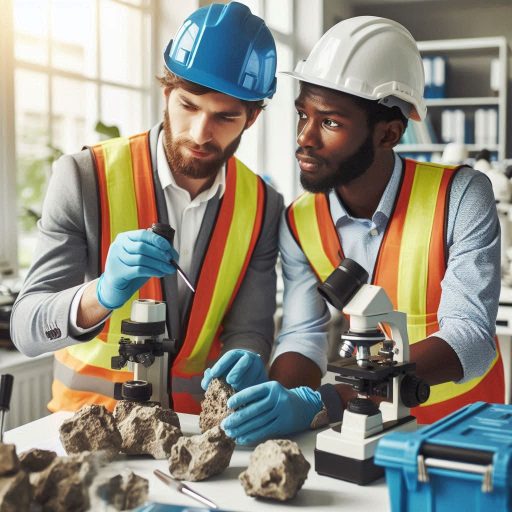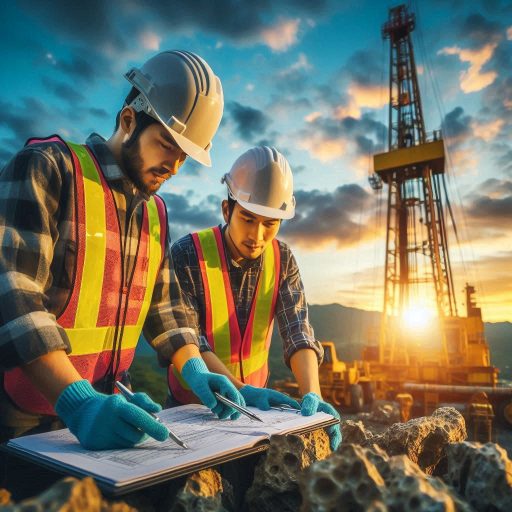Introduction
Importance of Safety Practices for Petroleum Technicians
Safety practices are crucial for petroleum technicians to protect themselves and others.
Following safety protocols prevents accidents and reduces downtime.
Proper safety measures enhance operational efficiency in hazardous environments.
Technicians with strong safety habits minimize risks and ensure compliance with industry standards.
Overview of Potential Hazards in the Petroleum Industry
The petroleum industry is filled with potential hazards that can cause severe injury or death.
Common risks include exposure to toxic chemicals, extreme temperatures, and high-pressure systems.
Fire and explosion risks are prevalent due to the flammable nature of petroleum products.
Slips, trips, and falls are frequent in petroleum facilities due to slick surfaces.
Working in confined spaces poses additional risks, including oxygen deficiency and toxic gas buildup.
Electrical hazards, including arc flashes, threaten technicians working near high-voltage equipment.
Proper safety practices mitigate these dangers and ensure a safer working environment.
Prioritizing safety is essential for every petroleum technician’s health and job performance.
Personal Protective Equipment (PPE)
Different Types of PPE Used in the Industry
Petroleum technicians face various hazards in their daily tasks, making personal protective equipment (PPE) indispensable.
Each type of PPE is designed to address specific risks encountered in the field.
Helmets protect the head from impacts and falling objects, crucial in areas where overhead work or falling debris is a concern.
Safety glasses safeguard the eyes from splashes, dust, and flying debris.
Hearing protection, such as earplugs or earmuffs, is essential in environments with high noise levels to prevent hearing damage.
Gloves are necessary to protect hands from cuts, burns, and chemical exposure.
Steel-toed boots provide protection for feet against heavy equipment and sharp objects.
Respirators are vital for filtering out harmful airborne substances, ensuring safe breathing in contaminated environments.
Fire-resistant clothing is designed to shield the body from intense heat and flames, critical in environments with high fire risks.
Each piece of PPE is tailored to mitigate specific hazards, emphasizing the importance of using the appropriate gear for different tasks.
Importance of Wearing PPE at All Times
Wearing PPE consistently is crucial for ensuring safety in the petroleum industry.
PPE acts as a critical barrier between technicians and potential hazards.
It significantly lowers the risk of injuries and health issues, such as burns, cuts, or respiratory problems.
Neglecting to wear PPE can lead to severe accidents and long-term health effects.
Proper use of PPE also ensures compliance with industry regulations and safety standards, which helps avoid legal repercussions.
Consistent PPE usage promotes a culture of safety within the workplace, fostering awareness and vigilance among all team members.
By always wearing PPE, technicians protect themselves and contribute to the overall safety of their colleagues.
The practice of wearing PPE at all times reinforces the importance of safety and encourages a proactive approach to hazard management.
Training on Proper Use and Maintenance of PPE
Effective training on PPE is essential for ensuring its proper use and maintenance.
Technicians must receive comprehensive instructions on how to correctly wear and use each type of PPE.
Training should include guidance on proper fitting to ensure that PPE offers maximum protection and comfort.
Technicians need to be educated on how to inspect PPE for signs of wear and damage, and understand when to replace it.
Proper cleaning and maintenance practices are crucial to extend the life of PPE and maintain its effectiveness.
Organizations should provide hands-on training sessions and regular updates to keep technicians informed about the latest safety practices and equipment.
This ongoing education helps technicians stay adept at managing safety hazards and adhering to industry standards.
By investing in thorough training, organizations ensure that their workforce is well-prepared to handle risks safely and effectively.
Read: Impact of Drones on Surveying and Mapping
Emergency Response Plan
Developing and Practicing an Emergency Response Plan
In addition to PPE, having a well-developed and practiced emergency response plan is crucial for the safety of petroleum technicians.
Emergencies can occur unexpectedly, and being prepared can make a significant difference in outcomes.
An emergency response plan outlines the steps to take in various emergency scenarios, ensuring that all team members know their roles and responsibilities.
Developing this plan involves identifying potential risks, assessing the workplace for hazards, and determining the best course of action for different types of emergencies.
The plan should be comprehensive, covering everything from minor incidents to large-scale emergencies, such as fires, chemical spills, and explosions.
Procedures for Handling Different Types of Emergencies
Each type of emergency requires specific procedures to ensure safety and minimize damage.
For instance, in the event of a fire, the protocol might include sounding alarms, using fire extinguishers, and evacuating the area.
For chemical spills, the procedure may involve containing the spill, using appropriate neutralizing agents, and donning additional PPE.
Technicians must be trained to respond quickly and effectively to each type of emergency.
This training should include regular drills and simulations to help them practice the procedures in a controlled environment.
These drills ensure that everyone knows how to act swiftly and efficiently, reducing panic and confusion during real emergencies.
Ensuring All Team Members Are Familiar with the Plan
For an emergency response plan to be effective, all team members must be familiar with it.
This familiarity comes from regular training, clear communication, and continuous practice.
Every team member should know the location of emergency exits, fire extinguishers, and first aid kits.
They should also understand the communication protocols, such as who to contact and how to report an emergency.
Supervisors should ensure that all new hires receive immediate training on the emergency response plan and that this training is refreshed periodically for all staff.
Regular reviews and updates to the plan are also necessary to account for changes in the workplace, such as new equipment, updated procedures, or emerging risks.
Read: Top Surveying and Mapping Technician Employers
Transform Your Career Today
Unlock a personalized career strategy that drives real results. Get tailored advice and a roadmap designed just for you.
Start NowHazard Communication
Understanding the Chemical Hazards Present in the Workplace
Petroleum technicians work in environments where chemical hazards are common.
Understanding these hazards is the first step in developing an effective emergency response plan.
Begin by identifying all chemicals used or stored in the workplace.
Evaluate the potential risks associated with each chemical, such as flammability, toxicity, or reactivity.
Knowing these risks allows you to tailor your emergency response plan to address specific dangers.
Proper Labeling and Storage of Chemicals
Proper labeling and storage of chemicals are vital for safety.
Every chemical container should be clearly labeled with the substance’s name, hazards, and handling instructions.
Storing chemicals in appropriate containers and locations reduces the risk of accidental exposure or spills.
For example, flammable chemicals should be stored in fire-resistant cabinets, while corrosive substances must be kept in containers that prevent leaks.
Proper labeling and storage not only protect workers but also streamline emergency responses by providing essential information at a glance.
Training on How to Interpret Safety Data Sheets (SDS)
Understanding and interpreting Safety Data Sheets (SDS) is crucial for handling chemicals safely.
SDS provide detailed information about the properties, hazards, and safe handling procedures for each chemical.
Train all team members on how to read and interpret SDS.
This training should cover recognizing hazard symbols, understanding exposure limits, and knowing the correct first aid measures.
Ensuring that everyone can interpret SDS accurately is a key component of your emergency response plan.
Read: Safety Tips for Field Surveying Technicians

Equipment Maintenance
Importance of Regular Maintenance of Equipment and Machinery
Regular maintenance of equipment and machinery is crucial for ensuring safe operations in the petroleum industry.
Well-maintained equipment operates more efficiently and is less likely to fail, reducing the risk of accidents.
Preventative maintenance can identify potential issues before they become serious problems, preventing costly repairs and downtime.
Regular maintenance also ensures that machinery is operating within its designed specifications, reducing the likelihood of malfunctions.
By prioritizing maintenance, companies can extend the lifespan of their equipment, providing better returns on investment.
Moreover, well-maintained machinery contributes to a safer work environment, as it minimizes the risks associated with equipment failure.
Ensuring Safe Operating Conditions for All Equipment
Ensuring safe operating conditions for all equipment is a key responsibility for petroleum technicians.
Before using any machinery, technicians should conduct thorough inspections to confirm that the equipment is in good working order.
This includes checking for signs of wear, ensuring that all safety features are functional, and verifying that the equipment is being used according to manufacturer guidelines.
Proper calibration and alignment of machinery are also critical to maintaining safe operating conditions.
Any deviation from standard operating procedures should be immediately addressed to prevent accidents.
Maintaining safe operating conditions is not just about preventing equipment failure; it also involves ensuring that the working environment is safe for everyone involved.
Procedures for Reporting Any Faulty Equipment
Proper procedures for reporting faulty equipment are essential to maintaining a safe work environment.
Petroleum technicians should be trained on how to identify and report any equipment that shows signs of malfunction or damage.
Immediate reporting allows for quick corrective actions, preventing potential accidents.
Technicians should know the correct channels for reporting issues, whether it’s through a supervisor, a safety officer, or a maintenance department.
Detailed reporting, including the nature of the fault and any unusual behavior observed, helps maintenance teams address issues more effectively.
Prompt reporting not only ensures the safety of the technician but also protects the entire team from potential hazards associated with faulty equipment.
Read: Recent Trends in Surveying and Mapping Technologies
Fire Safety
When it comes to safety practices for petroleum technicians, fire safety is a critical aspect that cannot be overlooked.
Here are some key points to consider:
Implementing fire prevention measures in the workplace
One of the first steps in ensuring fire safety is to implement fire prevention measures in the workplace.
This includes conducting regular risk assessments, identifying potential fire hazards, and taking steps to mitigate these risks.
For example, ensuring that electrical equipment is properly maintained and that flammable materials are stored in designated areas can help prevent fires from starting in the first place.
Proper storage and handling of flammable materials
Proper storage and handling of flammable materials is paramount to preventing fires in the workplace.
This includes storing flammable liquids in approved containers and keeping them away from potential ignition sources.
It is also important to ensure that there are clear labeling and marking on containers to indicate the contents and potential hazards.
Training on how to use fire extinguishers
Training on how to use fire extinguishers is essential for all petroleum technicians.
In the event of a fire, knowing how to quickly and effectively use a fire extinguisher can make a significant difference in containing and extinguishing the fire before it spreads.
Regular training sessions should be conducted to ensure that all employees are familiar with the proper techniques for using a fire extinguisher.
Overall, fire safety is a crucial aspect of ensuring the well-being of petroleum technicians and preventing workplace accidents.
By implementing fire prevention measures, properly storing and handling flammable materials, and providing training on how to use fire extinguishers, organizations can create a safer work environment for everyone involved.
Confined Space Entry
Procedures for Entering and Working in Confined Spaces
Confined spaces in the petroleum industry present unique dangers, including limited access, poor ventilation, and potential exposure to hazardous substances.
Before entering a confined space, technicians must follow strict procedures to ensure safety.
These procedures include conducting a thorough risk assessment to identify potential hazards.
Technicians must obtain proper authorization and ensure that all necessary safety equipment is in place.
It’s essential to have a standby person outside the confined space who can communicate with the technicians inside and initiate rescue operations if needed.
Continuous monitoring of the atmosphere within the confined space is crucial to detect harmful gases or insufficient oxygen levels.
Adhering to these procedures minimizes the risk of accidents and ensures a safe working environment.
Importance of Proper Ventilation and Monitoring
Proper ventilation and continuous monitoring are critical when working in confined spaces.
Poor ventilation can lead to the buildup of toxic gases or a lack of oxygen, both of which can be fatal.
Ventilation systems must be set up to ensure a constant supply of fresh air and to remove any hazardous fumes or gases.
In addition to ventilation, continuous atmospheric monitoring is necessary to detect any changes in air quality.
Technicians should use gas detectors and other monitoring equipment to ensure that the air remains safe to breathe.
Any deviation from safe levels should trigger an immediate evacuation of the confined space.
Proper ventilation and monitoring are essential to prevent suffocation, poisoning, or other serious health risks associated with confined spaces.
Training on Rescue Procedures in Case of an Emergency
Emergencies can occur at any time, and petroleum technicians must be prepared to respond effectively.
Training on rescue procedures is crucial, particularly for situations involving confined spaces or hazardous conditions.
Technicians must be familiar with the emergency response plan, including how to safely evacuate and assist others in distress.
Rescue drills should be conducted regularly to ensure that all personnel know their roles and can act quickly in an emergency.
It’s also important to train technicians on the use of rescue equipment, such as harnesses, ropes, and breathing apparatuses.
Having a well-practiced rescue plan can make the difference between life and death in an emergency situation.
Continuous training ensures that technicians are prepared to handle emergencies with confidence and efficiency.
You Might Also Like: Top Skills Needed for Environmental Technicians
Fall Protection
Working at heights is a common part of a petroleum technician’s job, whether they are inspecting equipment on top of storage tanks or conducting maintenance on elevated platforms.
It is crucial for technicians to prioritize fall protection to ensure their safety while performing these tasks.
Proper Harness and Equipment
When working at heights, technicians must use the appropriate harness and equipment to prevent falls.
A full-body harness that fits properly and is in good condition should be worn at all times when working at height.
Additionally, technicians should use lanyards, lifelines, and anchorage points that are rated for the intended load to ensure they are secure while working.
Training on Safe Practices
Proper training on safe practices for working on elevated platforms is essential for petroleum technicians.
They should be familiar with the correct procedures for ascending and descending from heights, as well as how to properly use fall protection equipment.
Regular safety training sessions should be conducted to keep technicians updated on the latest fall protection techniques and equipment.
Transform Your Career Today
Unlock a personalized career strategy that drives real results. Get tailored advice and a roadmap designed just for you.
Start NowInspections of Fall Protection Equipment
Regular inspections of fall protection equipment are necessary to ensure that it is in good working condition.
Technicians should inspect their harnesses, lanyards, lifelines, and anchorage points before each use to check for any signs of wear or damage.
If any equipment is found to be defective, it should be taken out of service immediately and replaced with new, properly functioning equipment.
In essence, fall protection is a critical aspect of safety practices for petroleum technicians working at heights.
By ensuring they have the proper harness and equipment, receiving training on safe practices, and conducting regular inspections of fall protection equipment, technicians can minimize the risk of falls and work safely at height.
Conclusion
The importance of safety practices for petroleum technicians
Safety practices are crucial for petroleum technicians to ensure their well-being and the safety of others.
Adhering to safety protocols minimizes the risk of accidents and equipment failures.
Proper handling of hazardous materials and tools protects technicians from potential injuries.
Emphasizing the need for continuous training and vigilance in the workplace
Continuous training plays a vital role in maintaining safety standards in the workplace.
Regular updates on safety procedures help technicians stay current with industry regulations.
Vigilance in the workplace prevents complacency, which can lead to dangerous oversights.
Key points to remember include:
- Regular Training: Keep skills sharp and stay informed about new safety measures.
- Constant Vigilance: Always be alert to potential hazards and take immediate action to mitigate risks.
- Safety First: Prioritize safety above all else to protect yourself and your team.
By following these practices, petroleum technicians can maintain a safe working environment.
Remember, safety is not a one-time effort but an ongoing commitment.
Stay trained, stay vigilant, and always prioritize safety on the job.




